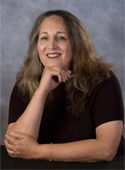Brief Biography Of Tarynn Madysyn Witten, Ph.D. 
Tarynn Madysyn Witten, a native of Boston, Massachusetts, obtained her A.B. (mathematics and physics, magna cum laude) at Boston University (Boston University) in 1972. She graduated Phi Beta Kappa, Scarlet Key, Delta Honor Society, and was awarded a Boston University Harold C. Case Scholar Award for academic excellence. Among many of her achievements, Tarynn founded the Boston University Physics Club Photon, (1970) served as its initial president as well as initiated the Boston University Chapter of Sigma Pi Sigma (1970). While at BU, she captained the William Lowel Putnam Mathematics squad in both her Junior and Senior years.
After receiving an M.S. in Mathematical Physics at Indiana University Bloomington (Indiana University Bloomington), she moved to Buffalo, and obtained an M.S. and Ph.D. (1977) in Mathematical Biology/Medicine at SUNY at Buffalo(University of Buffalo), Center for Theoretical Biology, where she studied with Robert Rosen (Picture of Robert Rosen)(Biological Extinction of Iterates of Functions with Finite Domain, outside reader Sir Robert May). Her PhD thesis work was among the earliest application of dynamical systems theory and topological dynamics to the behavior of discrete dynamical models of biological populations.
Following her doctoral years, Tarynn spent postdoctoral research time at the Department of Biometry, Medical University of South Carolina (Medical University of South Carolina) (Robert Duncan, advisor) and the Department of Laboratory Medicine, Medical University of South Carolina (Armand Glassman, advisor) where she studied and modeled the effects of abrin and cysplatin on EBV-transformed and normal lymphocyte DNA, RNA, and protein synthesis.
Tarynn then moved to the Department of Biomedical Engineering (Fred Grodins, George Moore, advisors), University of Southern California ( University of Southern California). While at the University of Southern California , she also studied with Richard Bellman (nonlinear partial differential equation models of cellular dynamics of aging), Robert Kalaba (quasilinearization methods for hyperbolic partial differential equations arising in population biology), and Bernard Strehler (theoretical models of population survival in aging). And worked with F. Eugene Yates as part of his joint UCLA-USC Biomedical Engineering think tank. While at USC, Tarynn developed a longstanding collaboration with Kenneth L. Cooke, Stavros Busenberg, and Rick Elderkin (stochastic population models, models of cellular aging arising out of demographic applications).
Subsequently, Tarynn held faculty positions at the University of California Santa Barbara (Mathematics) (University of California Santa Barbara), Illinois Institute of Technology (Mathematics) ( Illinois Institute of Technology), University of Louisville School of Medicine (Community Medicine) jointly with the University of Louisville Speed Scientific School of Engineering and Mathematics ( University of Louisville), as well as the University of Minnesota-Minneapolis (Computer Science) ( University of Minnesota Minneapolis) where she also spent time at the Institute for Mathematics and its Applications ( Institute for Mathematics and It's Applications). She has also worked for Planning Research Corporation and for ETA Systems/Control Data Corporation.
With the demise of ETA Systems, Tarynn moved to the University of Texas System Center for High Performance Computing (CHPC), now known as the Texas Advanced Computing Center (TACC) where she served as Head of the Department of Applications Research and Development and as the Center Associate Director until the CHPC was closed and revamped. During her time at the CHPC, she organized the Computational Genomics group, the Computational Physiology group and coordinated the use of the CHPC facilities with all of the UT System components, focussing on biological and biomedical use. As part of her attempts to increase the utilization of the facilities, she instigated the development of the GenTools project.
(Encyclopedia of Computer Science-Computational Biology and Medicine), where she also served as Associate Director of the Center as well. During this period of time, she organized the First World Congress on Computational Medicine, Biology, and Public Health - Congress Poster and initiated the development of an internationally competitive group in Computational Molecular Biology and Genetics which developed the first computationally viable trans-platform computational molecular biology and genetics analysis package (GenTools(tm)) GenTools -Electronic Laboratory Notebook, GenTools -Queue Environment, GenTools -Alignment Visualizer, GenTools -Multiple Sequence Aligner, GenTools -Molecular Viewer collaborating with Los Alamos GenBank and numerous other software developers in the early 1990's. In addition, she held an appointment as Associate Professor of Physiology at the University of Texas Health Science Center San Antonio ( University of Texas Health Science Center at San Antonio), and Associate Professor of Biomedical Engineering at the University of Texas at Austin ( University of Texas at Austin). She has also served as Chief Information Officer of the University of Michigan Medical Center Comprehensive Gender Services Program ( University of Michigan Ann Arbor). While at U of M, she also served as Research Scientist - Reproductive Sciences Program, University of Michigan Medical School, Research Scientist - Institute of Gerontology , University of Michigan Medical School, as well as Adjust Associate Professor of Mathematics, University of Michigan College of Arts and Sciences.
Most recently, she is served as a Professor in the Department of Community Dentistry at the University of Texas Health Science Center San Antonio where she also served as the Dental School biostatistician and mathematical modeling/simulation expert.
Recently, she was a Professor of Mathematics at Trinity University, San Antonio, Texas.
Currently, Tarynn is Associate Professor of Biological Complexity, Senior Fellow, and Director of Research and Development at the Virginia Commonwealth University, Center for the Study of Biological Complexity, Richmond, Virginia. She also serves as an Associate Professor of Emergency Medicine and Gerontology, as well as Adjunct Associate Professor of Social Work. In addition, she is a Research Assistant Professor in the Department of Biostatistics.
Her research interests lie in the study of aging processes at all levels of biological organization Mathematical and Computational Methods in Aging Research - Part A and Mathematical and Computational Methods in Aging Research- Part B . Much of her work has been done in cellular population modeling with respect to studying the problem of cancer-aging dynamics, using ode and pde models, along with dynamical systems approaches. More recently, she has extended her interests into two specific areas, methodologies for studying high dimensional complex datasets and computational medicine/public health( Drug Adherence Visualization 1 , Drug Adherence Visualization 2 ). These applications areas tend to be computationally intensive, to require sophisticated visualization techniques (audio, visual, sensory) Development of the Weaver graphical data analysis interface using AVS , and to offer an abundance of research problems here-to-fore intractable with respect to the lack of biological/clinical understanding, computational power, and analytical tools and techniques.In addition, she has extended her work to encompass epidemiological and public health issues in minority populations, women's health and gender related health issues, and issues of violence in minority populations. Along her modeling efforts, she is actively involved in issues of survival analysis (Sample simulation and parameter estimation for diet restricted and ad libitum rats), survey and sample design (Sample simulation for sample size determination in skeletal muscle small motor unit estimates for innervation ratio; work with William Kuzon), (Algorithm for sample size simulation), (Evaluation of the effect of sample size on estimates of motor unit innervation ratio), (Estimation of motor unit innervation ratio), and clinical trials modeling.






